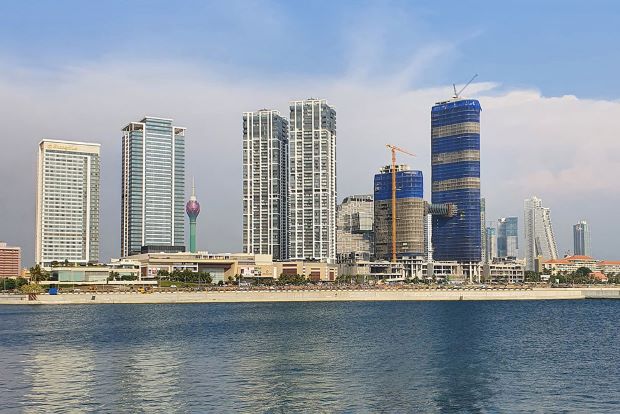Down but not out – does Sri Lanka have what it takes to get back on its feet?
By Suzannah Jessep
In March 2023, the Asia New Zealand’s Foundation’s director research and engagement Suz Jessep and executive director Simon Draper visited Colombo, Sri Lanka, to establish connections with partner organizations and grow the Foundation’s pool of Asia experts. In this article, Suz reflects on Sri Lanka’s recent economic turmoil and finds inspiration in the next generation of leaders who are eager to see Sri Lanka live up to its reputation as the jewel of South Asia
We arrived in Colombo the week the International Monetary Fund (IMF) announced that they had concluded their talks with the Sri Lankan government and would shortly vote on a US$ 2.9 billion rescue package designed to pull Sri Lanka from the brink of economic Armageddon. For many, this felt like déjà vu. In 2016, the IMF had agreed a similar, albeit smaller, bailout package of US$ 1.5 billion in order to avert a balance of payments crisis. In 2023, however, the crisis had struck and it had struck hard.
In three short years, Sri Lanka had gone from being one of the richest, most developed, upper middle-income countries in the region, to defaulting on its payments and tumbling into debt. On the ground, we heard stories of anger, vulnerability, and hardship from the people left queuing for their basic food and fuel needs. But we also heard stories of resilience and determination. This is a country that has survived a 34-year-long civil war, the devastating impacts of the Boxing Day tsunami where over 35,000 people lost their lives, the 2019 Easter weekend terror attacks that killed 269, and then the Covid pandemic.
There is no question Sri Lanka has all the attributes of a jewel in South Asia, with a strategically important geographical location, natural resources, an industrious and educated population, beautiful and accessible coastline, and ambient temperatures. Many governments, including New Zealand, have invested heavily in growing their relationship with Sri Lanka and supporting its development ambitions. While headlines over Sri Lanka’s debt to China and sale of its strategic assets have made Sri Lanka somewhat of an unwitting posterchild for the negative effects of major-power competition, on the ground Sri Lanka feels vibrant, dynamic and full of potential.
During our visit we asked Sri Lankan businesspeople, journalists, commentators, and young leaders how they felt about their country. Despite recent challenges, almost all felt optimistic. They were the ones who had decided to stay and wanted to make a positive contribution to Sri Lankan society. Many others had chosen to leave.
We heard Sri Lanka had recorded a net emigration of more than 600,000 people since the economic crisis, reflecting a sharp brain-drain and the fact that Sri Lankans with money had voted with their feet.
We heard many Sri Lankans express their interest in having outside voices and new ideas to help Sri Lanka address its development and governance challenges. The female business leaders we spoke to talked about the value they saw in having connections with other entrepreneurs from across the region. They exist in a small eco-system, but were impressive and expansive in their outlook. They’re keen to foster networks with other innovators and young leaders, and they’re keen to work with New Zealand to co-design solutions to shared challenges.
In a meeting with a leading thinktank, Pathfinder Foundation, we agreed to establish a Track II dialogue together – to share perspectives on our region and outlook. It’s clear we are grappling with many of the same issues, but from opposite ends of Asia.
In the arts, there is a vibrancy and rich story-telling that reflects Sri Lanka’s hardships but also – like New Zealand – the fact they are an island and so have adopted an outward looking stance to connect with the world. Film and documentary makers are capturing Sri Lanka’s daily life and they’re keen for stories from New Zealand. Sri Lankan writers are being recognized internationally, with Shehan Karunatilaka (who moved to Whanganui with his family in 1990 when he was 15 to escape the civil war in Sri Lanka) winning this year’s Booker prize.
Galleries are packed with phenomenal art, exploring Sri Lanka’s past, present and future. Businesses and media houses are keen to host New Zealand interns, as a way of exchanging ideas and helping young New Zealanders gain greater knowledge and confidence in Sri Lanka.
Despite all the obvious macro challenges besetting Sri Lanka, at a street level Colombo is bustling. Numerous large-scale and architecturally impressive construction sites are dotted across the city, funded by private investors and signalling a return at some stage to strong tourism and investment flows. While most government-funded works have been put on hold, Port City – a massive and ambitious international finance centre funded by China – also continues to slowly expand on reclaimed land on the city’s seafront.
Tourists are welcomed warmly, seen as an economic lifeline to reinvigorate small businesses, particularly in coastal and rural areas where economic hardship is felt most keenly.
Our visit ended with a surprising feeling of energy and determination. For all its troubles at a political level, Sri Lanka remains an amazing country in almost every other respect. For the Foundation, it seemed to be a good moment to be visiting and having these conversations with the next generation of leaders and change-makers. No country is immune from economic challenges, or to the erosion of its democracy. We can learn from each other’s experiences, but also be part of the solutions.
-Suzannah Jessep served as New Zealand’s Deputy High Commissioner to India, Sri Lanka and Bangladesh between 2016 and 2019. She is at present Director of Engagement and Research at the Asia New Zealand Foundation, where this article was originally featured



Comments are closed, but trackbacks and pingbacks are open.